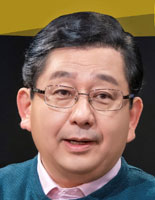
By Yuji Hosaka
Professor at Sejong University
Japan's policy toward the Korean Peninsula is composed of three stages, the first of which began with the Japan–Korea Treaty of 1876. The second was Japan's defeat of China in the Sino-Japanese War (1894-95) and subsequent blocking of Chinese influence on the peninsula. In the third stage, Japan colonized the peninsula and got rid of Russia's presence there after winning the Russo-Japanese War (1904-05) based on the Taft–Katsura agreement between the U.S. and Japan. So is Tokyo continuing to implement the same policy toward the Korean Peninsula today?
In December 2013, the Abe administration adopted the so-called National Security Strategy of Japan, which said, "To Japan, South Korea is an important region from a geopolitical perspective to resolve issues involving North Korea and China." Geopolitics is the study of how a country's geographical location influences politics and international relations. Nations such as the U.K., Germany and the U.S. have studied the field to find scientific proof and justifications for their respective national strategies.
The 18th-century German philosopher Immanuel Kant (1724-1804) was the first to study geopolitics in a systematic method under the title "political geography." The concept of political geography was eventually expanded in Germany, and the subject of geopolitics later became continental geopolitics. The basic logic of geopolitics in its early stage said, "A country is a highly developed organism and should attempt to expand its territory for survival," which justified a nation's territorial invasion of other states. It also supported imperialism by saying, "A country is dependent on its territory, and power is the first requirement for its survival before law."
Influenced by German geopolitics, British geographer Sir Halford John Mackinder (1861–1947) devised his heartland theory, referring to a territory two-thirds of which was ruled by Russia and China. His theory said world powers intended to rule the "heartland" or "pivot area," and the one that succeeded would rule the world. He also predicted that control of Eastern Europe, which was key to the rule of the heartland, would result in rule of the "world island," namely Europe, Asia and Africa. Nazi leader Adolf Hitler (1889-1945) put this theory into action by invading Poland and waging war on Russia (1941-45). Though Hitler ultimately failed, this became an important case of geopolitics.
In the U.S., political scientist Nicholas J. Spykman (1893-1943) came up with his Rimland theory that said, "The one who controls the Rimland, the strip of coastal land (that encircles Eurasia), will govern Eurasia and the fate of the world." He advised Washington to form an alliance with key countries in the Rimland, which he said contained invasion routes into the heart of the world. His theory served as the rationale for the trilateral alliance of the U.S., U.K. and Japan at the time of the Russo-Japanese War as well as America's bilateral alliances with Korea and Japan. Spykman also believed that the U.S. should prevent a country from becoming a superpower in the Rimland to prevent the blocking of invasion routes. Washington followed his advice by defeating Japan in the Pacific theater (1941-45) of World War II, and his theories and works still hold major influence over U.S. strategies.
Japan, another avid student of geopolitics as a maritime power, has always worked with the U.S. Both countries have had their eyes on the Eurasian continent. The Pacific theater of the Second World War was the only time the two sides fought each other.
In Japan, the faction of the Choshu Domain (a territory that is now Yamaguchi Prefecture) played a prominent role in the country until 1945, as imperial Japan concentrated on invasions and wars on the Korean Peninsula and in China. Many high-profile Japanese figures hailed from this faction including statesman Ito Hirobumi; Miura Goro, a lieutenant general who led the assassination of Empress Myeongseong of the Korean Empire; Masatake Terauchi, the first residential general of Joseon; and Count Hasegawa Yoshimichi, a field marshal who served as the second residential general of Korea and brutally suppressed the March First Independence Movement in 1919.
After World War II ended, the faction formed the predominant party system in Japan. Among faction members are former Japanese Prime Minister Nobusuke Kishi, a suspected A-list war criminal, and incumbent Prime Minister Shinzo Abe. Both did not originate from the conservative mainstream. Since World War II, the conservative mainstream in Japan has recognized the San Francisco regime, which was formed after the U.S. and Japan signed the San Francisco Peace Treaty in 1951 to build a peace regime in East Asia and consider Japan a former invading country with an apologetic attitude toward its neighboring countries.
Today, the Abe administration has stuck to the old mindset of the Choshu Domain as an imitator of or a collateral line of conservatives. Under this mentality, the administration could thus be said to seek putting Korea under Japanese influence. On the issues of abduction and sexual slavery of Korean women and forced Korean laborers before and during World War II and the recent dispute over patrol planes in neighboring waters, the Abe administration has never accepted Korea's contentions and instead blames Seoul for violating international law. This is because Tokyo cannot accept a situation in which Korea influences Japan.
If both Koreas set up a system of peaceful coexistence, Japan will inevitably have to change its policy toward the Korean Peninsula, which is based on the logic of the Choshu Domain faction. The essence of bilateral relations today lies in the so-called transitional collision between Korea's dynamic rise and Japan's outdated policy that cannot accept Korea's ascension. Thus if the inter-Korean peace process goes smoothly despite its ups and downs, Japan's policy toward the peninsula will face a big transformation.
Hosaka teaches political science at Sejong University in Seoul. As a naturalized Korean of Japanese descent, he is also director of the Dokdo Research Institute.
Translated by Korea.net staff writer Yoon Sojung